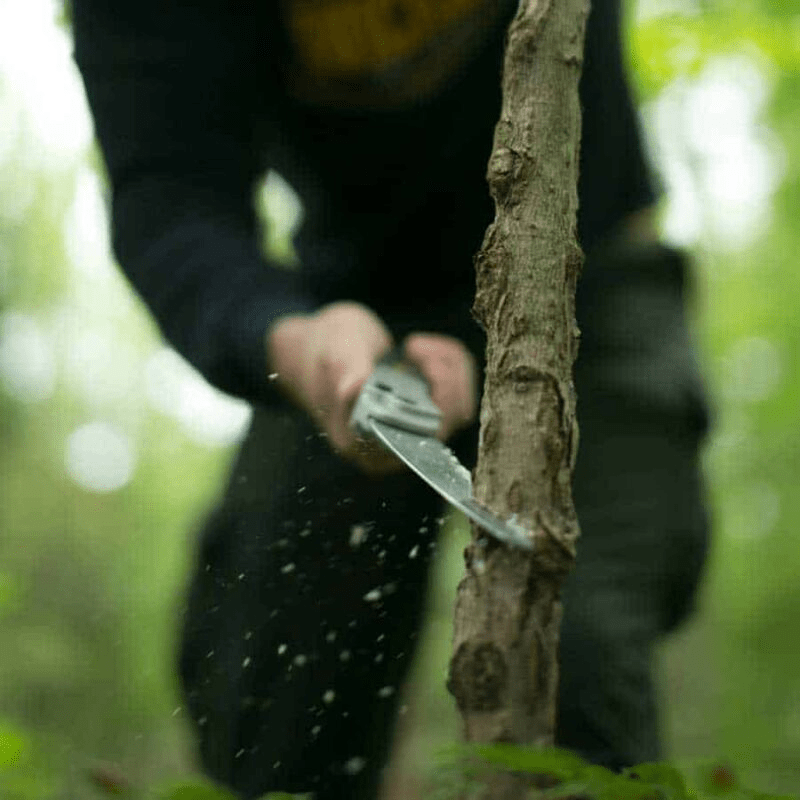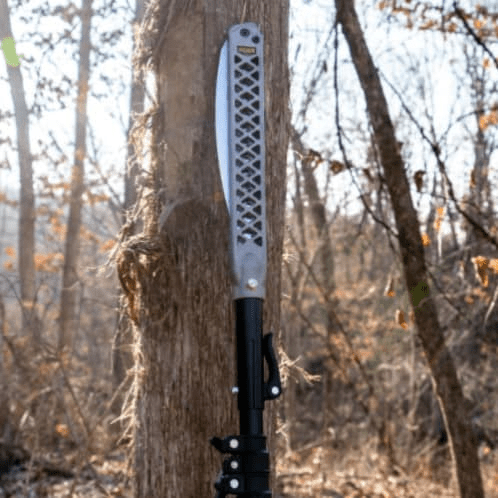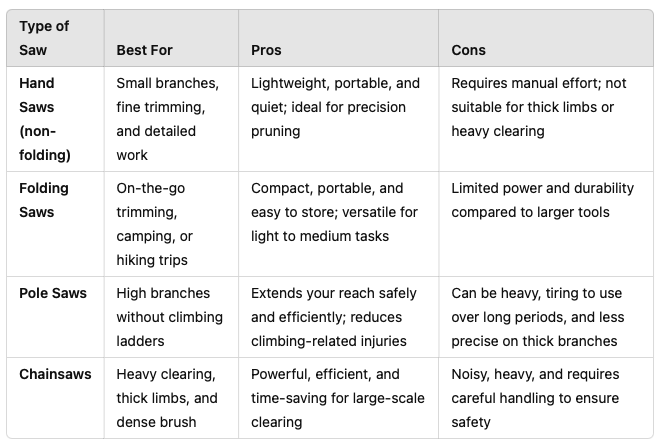Experienced hunters know the value of carrying a tree saw with them when they’re hunting game. Like any other tool in the hunter’s pack, a tree saw can help them clear their ideal line of sight, gather firewood, or remove branches for a tree stand.
This article will explore the types of tree saws and their uses as well as when you should use a tree saw versus another tool.
Importance of Clear Lines of Sight
The most obvious use for a tree saw is to create a clear shooting lane. If you’re hunting in heavy foliage or a forested area, you may have to put in a little work to give you a clear line of sight between your tree stand or blind and the area you’re focusing on. Even if you do have a viable shooting lane, you may need to expand it to allow for target movement.
If you’re setting up camp, you may have to clear a few limbs to accommodate your gear, sleeping area, and a fire pit. Clearing away limbs can also help you improve site security since you can see animals and other people approaching. If you deploy game cameras, you may need a saw to clear limbs and branches to maximize your view range.
Choosing the Right Saw for Your Needs
Like any other item in your pack, your saw needs to offer enough utility to justify its weight and space while serving multiple purposes. Choosing the right saw for your needs depends on the type of job you foresee needing it for, like the type of plants that you anticipate running into on your trip, or personal preferences. When choosing a saw, here are some things you should keep in mind:
The Type of Vegetation You’ll Encounter
Knowing the type of sawing jobs you’re likely to encounter is key to picking the right saw for your trip.
Lighter Foliage
In your experience, will you be mostly clearing thin branches and small saplings that are less than a couple of inches thick? If so, you can take advantage of a folding hand saw, like the Wicked Tough Hand Saw the hunter in this image is using:

It has a high carbon steel blade that locks out and a rubber grip over the aluminum handle. This handsaw folds to 8.25 inches and only weighs half a pound. It’s the saw you need, and it definitely earns its way into your pack.
Limbs and High Branches
If you’re trying to clear medium or thicker limbs that are higher above the ground, you may need a pole saw. If you’ve only used a pole saw for home pruning, you’re probably thinking of the cumbersome 6’-plus versions that you can pick up in the garden center of the hardware store. But the Wicked Tough Pole Saw in this picture is only 32” long and expands to 12 feet. It also weighs less than four pounds.

There’s also a 15’ version that weighs about a pound more and carries at 32” inches long. If you need the extra extension, we highly recommend this upgrade. If you just need a small extension over a handheld saw, Wicked Tough makes a 6’ model that’s small enough to fit in your pack when it’s broken down.
Dense and Thick Foliage
Many hunters would rather avoid bringing a chainsaw on their hunt. Chainsaws are noisy and are likely to scare the game away for several days. However, if you have a lot to clear, this may be your best option. Chain saws are heavy and bulky. You should only bring one if you’re certain you’re going to need it and there are no other options.
Ease of Use
Hand saws are probably the easiest to use, and you can carry them on your hip or in a pack pocket so you can get them out at any time. A pole saw isn’t really much more difficult once you have a little practice. If you’re dealing with overgrown paths, consider adding a machete to your kit (but not instead of the saw since they serve different purposes).
Portability
Most of the types of saws we’ve mentioned are fairly light, but the length of a pole saw makes it a little more cumbersome than a hand saw. However, as we’ve previously mentioned, even pole saws break down to a smaller size. Modern materials have made saws lighter while also making them increasingly durable.
Job Scope
Sometimes, you just don’t know how much clearing you’re going to be doing on a trip. However, if you do a little advanced preparation and scout the terrain, you can usually make an educated guess. A handsaw will almost always be sufficient for light trimming. You should probably have one with you, even if you don’t think you’ll be cutting branches at all. If you know you’re going to be cutting high limbs, bring a pole saw. Don’t ruin your trip trying to save a few pounds of weight.
Budget and Longevity
If you’re used to hunting equipment being expensive, we have good news for you. Hunting saws cost about as much as similar saws in your department stores. Some of them even have replaceable blades, so you don’t have to buy a new one every few years.
Types of Saws: Pros and Cons
Understanding the different types of saws helps you select the right tool for the job. Here are the main options, along with their pros and cons.

Each saw type has its purpose, so understanding the job at hand and the tool’s capabilities will ensure you make the right choice.
Proper Technique for Pruning
Pruning is an essential part of your hunting prep. Learning the proper technique can prevent you from damaging plant life and disrupting the ecosystem.
- Use sharp, clean tools to make precise cuts. Cutting at the correct angle — just outside the branch collar — can promote proper healing and prevent splitting or tearing, which can hurt the tree.
- Excessive pruning can stress trees and reduce their ability to recover. Over-pruning weakens trees by removing too much foliage. Never remove more than 25% of a tree’s foliage.
- If you’re concerned about noise, which is the case during most hunting trips, hand saws are much quieter than chain saws. This minimizes disturbance to wildlife and neighbors.
- Prune during dormant seasons (late winter or early spring) to reduce stress on the tree and promote robust growth during warmer months.
- Remember to keep clippings and tree limbs to assist with camouflage or to use as firewood if it’s dry enough.
Safe and Efficient Saw Use
Safety should always come first when using saws, especially since you will likely be miles away from quality healthcare. Proper technique, protective gear, and awareness are key to avoiding accidents.
Always wear safety gear, including safety glasses, heavy-duty gloves, and steel-toed boots to prevent your feet from being injured by falling branches. Use both hands to control pole saws and chainsaws. Always take a wide stance so you’re not thrown off balance when the blade cuts through. Pole saws are designed to cut higher limbs. Be careful about cutting any branches above your head. Don’t force the blade. It can kick back on you.
Always be mindful of your surroundings. Watch for power lines, unstable branches, and uneven ground. Keep an eye out for dangerous animals in the area while sawing.
Maintenance Tips
Keeping your saws in top condition ensures they remain safe and effective over time.
- Basic Cleaning: After each use, clean blades to remove sap, dirt, and debris. Wipe down metal parts to prevent buildup.
- Sharpen Blades: Regularly sharpen blades to maintain clean, precise cuts. Dull blades require more effort and increase the risk of injury.
- Rust Prevention: Store saws in dry, ventilated areas. Lightly oil blades after cleaning to protect against moisture and rust.
- Blade Replacement: Replace worn or damaged blades promptly to ensure safety and efficiency. Inspect blades for chips, cracks, or dullness after each use.
Seasonal Maintenance of Equipment
Seasonal care is essential to protect saws from damage and keep them ready for use.
- Protection from Rust: Store saws in a dry environment during off-seasons. Use blade covers or hang tools to prevent moisture buildup.
- Pre-Season Prep: Before heavy use periods, inspect tools for rust, sharpen blades, tighten loose components, and apply lubricating oil. This ensures tools are ready for the job.
- Post-Season Care: After a season of heavy use, clean saws thoroughly, oil blades, and store them properly. This prevents long-term damage and rust buildup.
- Storage Best Practices: Avoid leaving tools on the ground or exposed to weather. Proper storage ensures saws last for many years without requiring constant repairs or replacements.
If you plan properly, you can usually get away with carrying a single saw in your hunting pack. However, if you know you’re going to need a pole saw, it’s not a bad idea to also pack a hand saw. You can find tree saws and much, much more at FeraDyne. Order your hunting equipment today!
